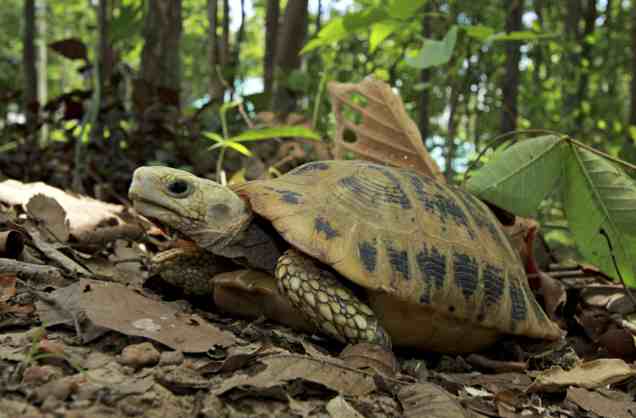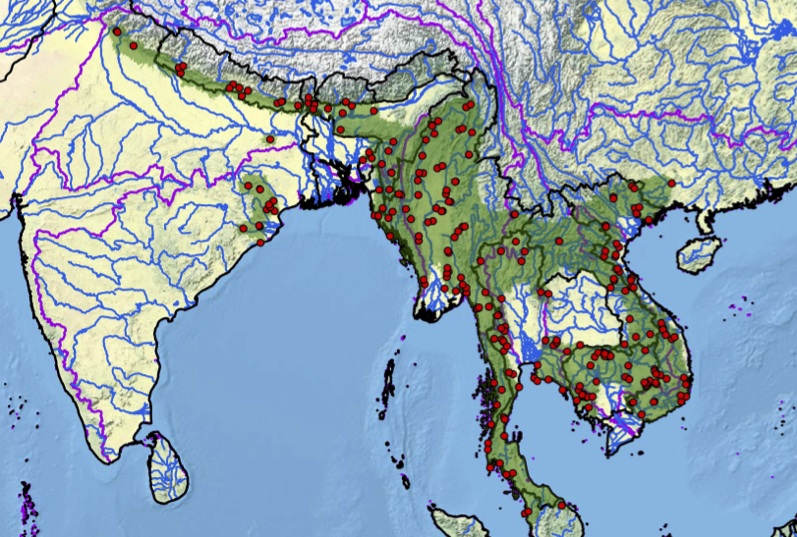Indotestudo elongata, 096
Indotestudo elongata (Blyth 1854) –
Elongated Tortoise, Yellow-headed Tortoise, Yellow Tortoise
Flora Ihlow1, Jeffrey E. Dawson2, Timo Hartmann1, and Sitha Som3
1Zoologisches Forschungsmuseum Alexander Koenig,
Adenauerallee 160, 53113 Bonn, Germany [[email protected], [email protected]];
2Saint Louis Zoo, 1 Government Drive, St. Louis, Missouri 63110 USA [[email protected]];
3Wildlife Conservation Society, 21 Sangkat Tonle Bassac, Khan Chamkarmorn,
Phnom Penh, Cambodia [[email protected]]
Summary. – The Elongated Tortoise, Indotestudo elongata (Family Testudinidae), is a medium-sized tortoise with a straight carapace length of up to 360 mm. The species is sexually dimorphic; among the morphological differences between the sexes, males and females differ in facial coloration during the breeding season. Indotestudo elongata inhabits low to mid-elevation habitats in Southeast Asia: open deciduous dipterocarp forests, grasslands, bamboo forests, secondary forests, and hilly evergreen forests. The species is a generalist omnivore. In the wild, courtship and mating take place at the beginning of the rainy season. Clutches of up to 10 eggs are laid toward the end of the wet period; hatchlings emerge from the nest at the beginning of the subsequent rainy season. The species is heavily exploited by humans for food and traditional medicine across its range. In addition, I. elongata is greatly affected by habitat destruction, fragmentation, and loss. As a result, although protected by international and national regulations, the species has undergone severe population declines. Recommended conservation measures include greater enforcement of wildlife protection laws, conservation breeding and monitored releases of tortoises, and continued research.
Distribution. – Bangladesh, Bhutan, Cambodia, China (Guangxi), India (Assam, Bihar, Jharkhand, Meghalaya, Mizoram, Odisha, Sikkim, Tripura, Uttarakhand, Uttar Pradesh, West Bengal), Laos, Malaysia (Kedah, Penang, Perlis), Myanmar, Nepal, Thailand, Vietnam. Distributed over most of Southeast Asia, stretching from northern India, across Indochina, to southern China and northern Malaysia.
Synonymy. – Testudo elongata Blyth 1854, Peltastes elongatus, Testudo (Indotestudo) elongata, Indotestudo elongata, Geochelone elongata, Indotestudo elongata elongata, Geochelone (Indotestudo) elongata, Geochelone elongata elongata, Testudo parallellus Annandale 1913.
Subspecies. – None recognized.
Status. – IUCN 2015 Red List: Endangered (EN A1cd+2cd) (assessed 2000); TFTSG Draft Red List: Endangered (assessed 2011); CITES: Appendix II; Bangladesh Wildlife (Preservation) Act: Schedule III; Indian Wildlife (Protection) Act (1972): Schedule IV; Malaysia Wildlife Conservation Act (2010): Schedule I; Myanmar Wildlife Law (1994): Protected; Thailand Wildlife Animal Reservation and Protection Act (1992 Revised): Listed; Vietnam Decree No. 32/2006/ND-CP: Group 2B.
Citation:
Ihlow, F., Dawson, J.E., Hartmann, T., and Som, S. 2016. Indotestudo elongata (Blyth 1854) – Elongated Tortoise, Yellow-headed Tortoise, Yellow Tortoise. In: Rhodin, A.G.J., Pritchard, P.C.H., van Dijk, P.P., Saumure, R.A., Buhlmann, K.A., Iverson, J.B., and Mittermeier, R.A. (Eds.). Conservation Biology of Freshwater Turtles and Tortoises: A Compilation Project of the IUCN/SSC Tortoise and Freshwater Turtle Specialist Group. Chelonian Research Monographs 5(9):096.1–14, doi:10.3854/crm.5.096.elongata.v1.2016, //iucn-tftsg.org/cbftt/.
(Adobe Acrobat 6.0 or later required)

Adult male Indotestudo elongata in Doi Phu Nang National Park, Phayao Province, northern Thailand.
Photo by Flora Ihlow.
Distribution:

Distribution of Indotestudo elongata in Southeast Asia. Purple lines = boundaries delimiting major watersheds (level 3 hydrologic unit compartments – HUCs); red dots = museum and literature occurrence records of native populations based on Iverson (1992), plus more recent and authors’ data; green shading = projected current distribution based on GIS-defined level 10 HUCs constructed around verified localities and then adding HUCs that connect known point localities in the same watershed or physiographic region, and similar habitats and elevations as verified HUCs (Buhlmann et al. 2009; TTWG 2014), and adjusted based on authors’ subsequent data.








